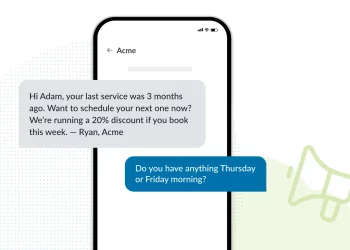In today’s world, SMS marketing is a key way for businesses to connect with people. However, following the law is essential, and the SMS footer is key.
An SMS footer provides essential information, such as who sent the message and how to stop receiving them. It makes messages clear and follows rules like the TCPA and CTIA.
You could face legal trouble if you don’t use SMS footers correctly. This article will show you how to make your messages good and legal.
Understanding SMS Compliance Regulations
Knowing the rules of SMS marketing is key. Some laws and guidelines tell businesses how to send texts:
Telephone Consumer Protection Act (TCPA)
The TCPA requires businesses to obtain express written consent to send ads. This consent must be explicit so people know they agree to receive messages.
Cellular Telecommunications Industry Association (CTIA) Guidelines
The CTIA gives tips for SMS marketing. They stress the need for explicit consent and easy ways to stop messages. Following these helps keep trust and avoid problems.
Federal Communications Commission (FCC) Rules
The FCC ensures that communication is safe for everyone. Its rules help stop unwanted messages and let people control what they receive.
Consent Requirements
- Express Written Consent: Needed for ads. It’s a clear yes from the person to get messages.
- Double Opt-In: A good idea where people confirm twice. It helps stop unwanted messages.
Opt-Out Obligations
- Clear Instructions: Messages should have easy ways to stop getting them (e.g., “Reply STOP to unsubscribe”).
- Timely Processing: Stopping messages when asked should happen fast to stay legal.
Essential Components of an Effective SMS Footer
A good SMS footer has a few essential parts:
Business Identification
It’s essential to say who sent the message. For example:
“ABC Corp:”
Opt-Out Instructions
Make it easy for people to stop messages:
“Reply STOP to unsubscribe.”
Help Information
Give ways to get help:
“Reply HELP for help.”
Message Frequency Disclosure
Tell people how often they’ll get messages:
“Msg freq varies.”
Data Rates Disclaimer
Let them know about message and data costs:
“Msg & data rates may apply.”
Privacy Policy Link
Link to your privacy policy for openness:
“Terms: [link]”
Best Practices for Crafting SMS Footers
To make your SMS footers work well and follow the law, follow these tips:
Conciseness
Keep them short to fit within limits. This keeps the main message clear.
Clarity
Use simple words to avoid confusion. Stay away from hard-to-understand terms.
Consistency
Keep your footer the same in all messages. This makes your brand easy to recognize.
Regular Updates
Update your footer when rules or company policies change. This keeps you in line with the law.
Automation
Use SMS tools that add the right footer to messages automatically. This cuts down on mistakes.
Common Mistakes to Avoid
Staying away from common mistakes helps protect your brand and keeps you legal:
Omitting Opt-Out Instructions
Not giving clear ways to unsubscribe can cause trouble. It also hurts trust with your audience.
Ambiguous Language
Unclear terms can confuse people. This might make them unhappy and could lead to complaints.
Neglecting Updates
Not updating your footer when rules change can get you in trouble. It’s important to stay current.
Overloading Messages
Too much info in a message can make it hard to read. Stick to the most essential stuff.
Examples of Compliant SMS Footers
Here are some good examples of SMS footers:
Example 1
“ABC Corp: Exclusive offer just for you! Reply STOP to unsubscribe. Msg & data rates may apply.”
Example 2
“XYZ Services: Your appointment is confirmed for 3 PM tomorrow. Reply HELP for assistance or STOP to opt out.”
Example 3
“123 Retail: New arrivals in store! Msg freq varies. Reply STOP to unsubscribe. Terms: [link]”
Advanced Best Practices for SMS Footers
1. Implement a 30-Day Footer Refresh Policy
To comply with rules and keep people informed, refresh your business information and opt-out details every 30 days. This helps if someone forgets they’re subscribed or if their number changes.
2. Maintain Comprehensive Consent Records
Tracking when and how people agreed to get SMS messages is essential. You should note how and when they consented (like through a form or text). This helps with following the rules and clears up any confusion later.
3. Regularly Audit and Update Contact Lists
People often get new phone numbers; old lists can send messages to the wrong people. Check your lists often to ensure you only send messages to those who want them. This helps avoid trouble and keeps people interested.
4. Customize Footers Based on Message Type
Make your SMS footers fit the message you’re sending. For example:
- Promotional Messages: Show who you are, how to stop messages, how often you send them, and where to find privacy policies.
- Transactional Messages: Although you might not need to, it’s smart to include opt-out information to be clear.
5. Incorporate Double Opt-In Mechanisms
Use a double opt-in method to ensure people want your messages. This means they confirm they want to subscribe after they sign up. It ensures your messages are wanted and keeps you out of trouble.
Real-World Examples of Effective SMS Footers
Example 1: Promotional Message
“ABC Corp: Enjoy 20% off your next purchase! Reply STOP to unsubscribe. Msg & data rates may apply. Terms: [link]”
Analysis: This footer clearly shows who sent it, how to stop messages, and mentions possible charges. It also links to terms, making everything clear and legal.
Example 2: Transactional Message
“XYZ Services: Your appointment is confirmed for 3 PM tomorrow. Reply HELP for assistance or STOP to opt out.”
Analysis: Although it’s a transactional message, including opt-out and help options, it shows you care about the user’s choices and needs.
Conclusion
Using these advanced practices in your SMS footer strategy helps you follow rules and build trust with your audience. By updating footers, keeping consent records, and customizing messages, businesses can improve their SMS campaigns. This respects user wishes and legal rules.
Frequently Asked Questions (FAQs)
1. What is an SMS footer, and why is it important?
An SMS footer is a text at the end of a message. It includes who sent it and how to stop getting messages. It’s key for:
- Identifying the sender builds trust and shows that the sender is sending the message. Built-in opt-out instructions let people easily stop messages, follow the rules, and respect their wishes.
Having another is important for being clear, following laws, and maintaining an image.
2. What elements should be included in a compliant SMS footer?
A good SMS footer should have:
- Business Identification: Show your company’s name.
- Opt-Out Instructions: Tell people how to stop messages with simple commands.
- Help Information: Give help options, like “Reply HELP for help.”
- Message Frequency Disclosure: Tell how often messages will come.
- Data Rates Disclaimer: Message and data rates may apply.
- Privacy Policy Link: Link to your privacy policy for openness.
These parts ensure people know what’s happening, and your messages follow the rules.
3. Are SMS footers legally required?
Rules about SMS footers can change, but they’re usually a good idea. They’re often needed by:
- Telephone Consumer Protection Act (TCPA): This law requires messages to clearly show who sent them and how to stop.
- Cellular Telecommunications Industry Association (CTIA) Guidelines: They stress being clear and letting users control messages.
Not having the correct info in your messages can cause legal trouble and hurt your brand.
4. How often should I update or refresh my SMS footer?
It’s smart to check and update your SMS footer often. This keeps you in line with new rules and best practices. Also, remind people about your business and how to unsubscribe now and then.
5. Can I customize my SMS footer for different types of messages?
Yes, you can make your SMS footer fit the message type. This makes things clearer and follows the rules better:
- Promotional Messages: Include all the usual footer stuff, focusing on how to stop messages and how often they’ll come.
- Transactional Messages: Even though they might not need opt-out info, it’s still a good idea to include it for clarity.
Customizing your footer makes sure people get the correct info for each message.
6. What are the common mistakes to avoid in SMS footers?
To keep your SMS footers practical and legal, steer clear of these mistakes:
- Omitting Opt-Out Instructions: Always give a straightforward way for people to stop getting messages.
- Using Ambiguous Language: Make sure your footer is easy to understand.
- Neglecting Updates: Keep your footer updated with new rules or company changes.
- Overloading Messages: Keep your footers short to avoid cutting off messages or overwhelming people.
By avoiding these common errors, you can keep a good relationship with your audience and follow the law.
7. How can I ensure that my SMS footers remain compliant over time?
To keep your SMS footers legal and practical:
- Stay Informed: Keep up with new laws and guidelines in the industry.
- Audit Practices: Regularly check your messaging and footers to ensure they follow the rules.
- Consult Legal Experts: Get advice from lawyers about marketing and telecom law.
- Implement Feedback Mechanisms: Ask for feedback from your recipients to catch any problems early.
Proactively improving your SMS practices is crucial for staying compliant and communicating well.














